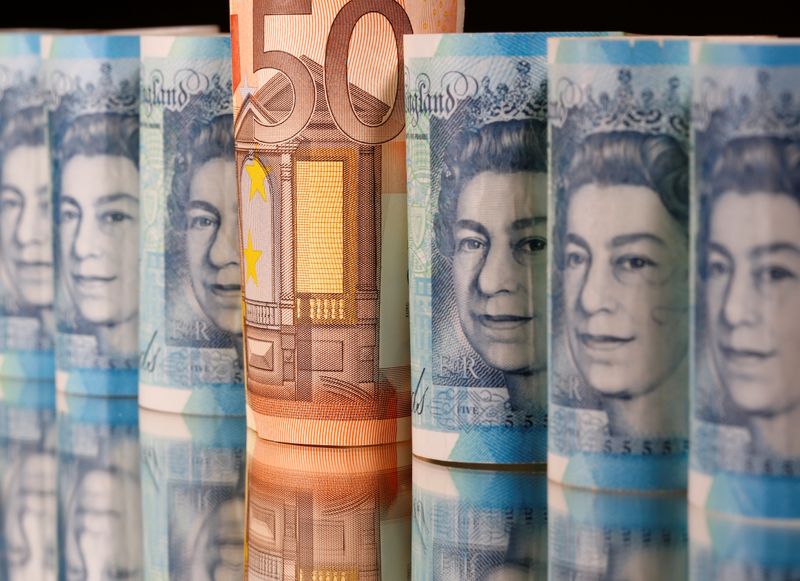By Gertrude Chavez-Dreyfuss
NEW YORK (Reuters) -The dollar fell from 10-day highs on Monday in a holiday-shortened week, as investors looked past concerns about a fast-spreading new coronavirus strain prevalent in Britain and focused on the U.S. stimulus package set to be voted on by Congress.
Analysts said volatile moves are typical at this time of the year when volumes are thin.
Market sentiment was helped as well by remarks from the World Health Organization, which tried to ease concerns about the latest virus mutation.
WHO said on Monday coronavirus mutations had so far been much slower than with influenza and that even the new UK variant remained much less transmissible than other diseases like mumps. It added that vaccines developed to combat COVID-19 should handle the new variants as well, although checks were underway to ensure this was the case.
“Level heads have prevailed once people realized that the variant will still be affected by the current vaccines being deployed,” said Amo Sahota, executive director at currency advisory firm Klarity FX in San Francisco.
“If it has been the case that the vaccines are not effective against this variant, then I think it’s a totally different situation.”
Investors have started to focus more on the U.S. stimulus bill that is likely to get voted later on Monday.
In afternoon trading, the dollar index fell 0.2% to 90.097, Last week, the safe-haven greenback sank to two-and-a-half-year lows, driven by optimism that vaccines would help to revive global growth. Earlier on Monday, it rose to a 10-day peak of 91.022.
The euro fell 0.2% to $1.22331, after earlier dropping to a more than one-week trough.
“We’ve noticed a couple waves of ‘buy-the-dip’ emerge in Europe today and we think this is because today’s pullback is a counter-trend,” said Erik Bregar, head of FX strategy, at Exchange Bank of Canada in Toronto.
Sterling fell to a 10-day low against the dollar and euro, as two-year British government bonds dropped to a record low. Prime Minister Boris Johnson sought an emergency response to the crisis.
The pound cut losses though versus the dollar to trade just 0.4% lower at $1.3448, while the euro clung to thin gains against sterling and was last up 0.1% at 90.85 pence.
Bitcoin, meanwhile, fell 2.7% after hitting a record high of $24,298.04 on Sunday. The virtual currency was last down at $22,844.18.
Total investor inflows into cryptocurrency funds and products hit $5.6 billion so far this year, up more than 600% from 2019, according to the latest data from asset manager CoinShares.
The riskier Australian and New Zealand dollars weakened at the start of the week as investors rushed for haven assets.
The Aussie dollar dropped 0.6% to 75.80 U.S. cents, while the New Zealand dollar fell 0.6% to 71 U.S. cents.
The U.S. dollar was little changed against the yen to 103.34 yen.
========================================================
Currency bid prices at 4:02PM (2102 GMT)
Description RIC Last U.S. Close Pct Change YTD Pct High Bid Low Bid
Previous Change
Session
Dollar index 90.1390 90.2810 -0.15% +0.00% +91.0220 +90.0150
Euro/Dollar $1.2231 $1.2260 -0.23% +9.10% +$1.2253 +$1.2130
Dollar/Yen 103.3050 103.3200 +0.03% -4.84% +103.8850 +103.2950
Euro/Yen 126.35 126.61 -0.21% +3.61% +126.6300 +125.9200
Dollar/Swiss 0.8854 0.8832 +0.27% -8.48% +0.8919 +0.8843
Sterling/Dollar $1.3447 $1.3528 -0.58% +1.41% +$1.3497 +$1.3190
Dollar/Canadian 1.2851 1.2788 +0.52% -1.05% +1.2956 +1.2784
Aussie/Dollar $0.7584 $0.7624 -0.52% +8.10% +$0.7605 +$0.7463
Euro/Swiss 1.0831 1.0821 +0.09% -0.19% +1.0847 +1.0799
Euro/Sterling 0.9092 0.9056 +0.40% +7.55% +0.9217 +0.9072
NZ $0.7100 $0.7142 -0.59% +5.51% +$0.7122 +$0.7003
Dollar/Dollar
Dollar/Norway 8.6320 8.5940 +0.47% -1.57% +8.8650 +8.6180
Euro/Norway 10.5592 10.5150 +0.42% +7.33% +10.7585 +10.5256
Dollar/Sweden 8.2480 8.2512 -0.31% -11.76% +8.4336 +8.2409
Euro/Sweden 10.0883 10.1193 -0.31% -3.64% +10.2356 +10.0938
(Reporting by Gertrude Chavez-Dreyfuss; Editing by Barbara Lewis and Alistair Bell)
























